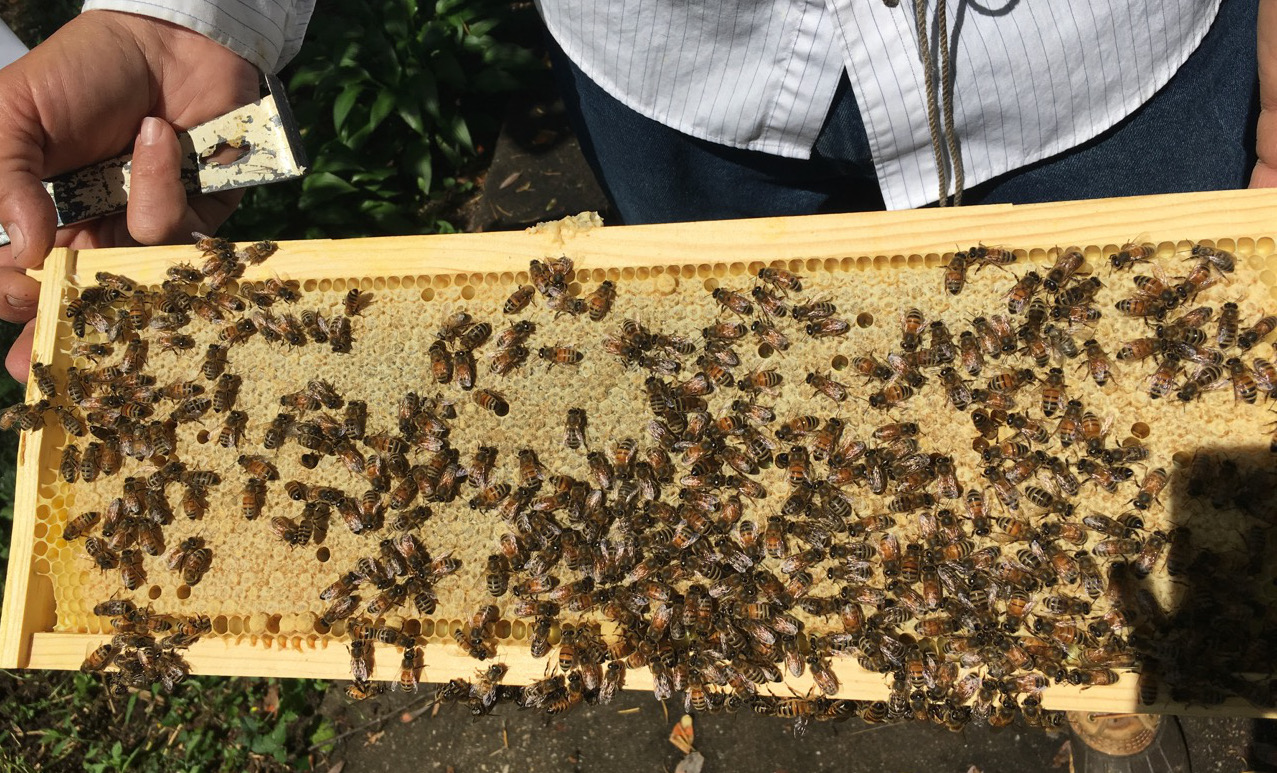Introduction / Motivation
As beekeepers, we are interested in helping bees, and other pollinators to thrive. There is a symbiotic relationship between plants and pollinators. Making plants available that feed pollinators will help honey bees and native pollinator species survive and thrive. Honey bees need nectar and pollen sources throughout the year.
Trees are the preferred nectar and pollen sources for honey bees in the Washington DC area. Trees only produce resources for bees for a short season. Before the “nectar flow” when the bee colonies are building up their numbers for spring, and after the nectar flow, honey bees still must find nectar and pollen to feed their brood and store for the winter. Flowering plants are the source of both.
To help bees and other pollinators, we need to provide flowers that bloom from January to November. Planting good wildflower mixtures provides bees and other pollinators with a consistent food supply. There are many bee-friendly and pollinator-friendly wildflower mixtures available at your local garden store or on the Internet. However, local pollinators need native plants.
Bee Daddies Apiaries searched for a wildflower mixture that is appropriate for the DC metropolitan area. We found a mixture that was curated by the Xerces Society for the Mid-Atlantic states and produced by the Ernst Conservation Seed Company. This mixture should be great for attracting and feeding pollinators in our area. Ernst only sells their mixtures by the pound. Most backyard beekeepers will not need a full pound. We purchased a bulk lot of these seeds and repackaged them into 2-oz. packets. We resold these packets at our cost to local gardeners and beekeepers.
We will give 3-gram packets of these wildflower seeds to any customer who purchases honey from us this year, while supplies last. We would encourage gardeners to plant these seeds to help feed bees and native pollinators. It is a small start … it takes acres of forage to feed a hive of bees, but if everyone replaced a patch of grass with a pollinator garden, we will be helping the bees replenish their honey stores, and the native pollinators to thrive.
Planting Hints
… coming soon …
Seed Composition from April 2019 Label
| Common Name | Botanical Name | P* | G* | H* | D* | O* |
|---|---|---|---|---|---|---|
| Little Bluestem ‘Camper’ | Schizachyrium scoparium ‘Camper’ | 31.09% | 93.0% | 3.0% | NE | |
| Purple Coneflower | Echinacea purpurea | 13.93% | 93.0% | 1.0% | OR | |
| Partridge Pea, PA Ecotype | Chamaecrista fasciculata, PA Ecotype | 9.99% | 50.0% | 28.0% | PA | |
| Lanceleaf Coreopsis | Coreopsis lanceolata | 9.87% | 77.0% | 13.0% | OR | |
| Butterfly Milkweed | Asclepias tuberosa | 3.20% | 76.0% | 17.0% | CA | |
| Tall White Beardtongue, PA Ecotype | Penstemon digitalis, PA Ecotype | 2.97% | 3.0% | 91.0% | PA | |
| Marsh (Dense) Blazing Star (Spiked Gayfeather) | Liatris spicata | 2.71% | 64.0% | 16.0% | OR | |
| Sensitive Pea, NC Ecotype | Chamaecrista nictitans, NC Ecotype | 2.00% | 34.0% | 45.0% | 11.0% | NC |
| Oxeye Sunflower, PA Ecotype | Heliopsis helianthoides, PA Ecotype | 1.99% | 49.0% | 43.0% | PA | |
| Smooth Blue Aster, NY Ecotype | Aster laevis, NY Ecotype | 1.42% | 34.0% | 44.0% | PA | |
| New England Aster, PA Ecotype | Aster novae-angliae, PA Ecotype | 1.34% | 81%TZ | PA | ||
| Anise (Lavender) | Agastache foeniculum | 1.00% | 85.0% | 12.0% | OR | |
| Narrowleaf Mountainmint | Pycnanthemum tenuifolium | 1.00% | 35.0% | 59.0% | PA | |
| Golden Alexanders | Zizia aurea | 1.00% | 90%TZ | IA | ||
| Heath Aster, PA Ecotype | Aster pilosus, PA Ecotype | 099% | 94%TZ | PA | ||
| Calico Aster | Aster lateriflorus | 0.90% | 71%TZ | PA | ||
| Wild Senna, VA & WV Ecotype | Senna hebecarap, VA & WV Ecotype | 0.90% | 42.0% | 36.0% | 15.0% | PA |
| Early Goldenrod, PA Ecotype | Solidago juncea, PA Ecotype | 0.89% | 80.0% | 5.0% | PA | |
| Hairy Beardtongue | Penstemon hirsutus | 0.86% | 98.0% | NJ | ||
| Wild Bergamot, Fort Indaintown Gap – PA Ecotype | Monarda fistulosa, Fort Indian | 0.80% | 84.0% | 14.0% | PA | |
| Common Milkweed | Asclepias syriaca | 0.76% | 93.0% | 1.0% | CN | |
| White Avens, PA Ecotype | Geum candadense, PA Ecotype | 0.67% | 94.0% | 3.0% | PA | |
| Gray Goldenrod, PA Ecotype | Solidago nemoralis, PA Ecotype | 0.60% | 22.0% | 46.0% | PA | |
| Blue False Indigo, Souther WV Ecotype | Baptisia australis, Southern WV Ecotype | 0.50% | 33.0% | 22.0% | 40.0% | PA |
| Roundhead Lespedeza, RI Ecotype | Lespedeza capitata, RI Ecotype | 0.50% | 95%TZ | PA | ||
| Orange Coneflower, Northern VA Ecotype | Rudbeckia fulgida var. fulgida | 0.50% | 97%TZ | PA | ||
| Wingstem, PA Ecotype | Verbsina alternifolia, PA Ecotype | 0.46% | 15.0% | 63.0% | PA | |
| Slender Lespedez, VA Ecotype | Lespedeza virginica, VA Ecotype | 0.40% | 7.3% | 50.9% | 25.5% | NC |
Other Crop : 0.02%
Inert Matter : 6.26%
Weed Seed : 0.05%
Cowpea/Peanut/Lespedeza inoc mixed in
Date Tested : April 2019
(*) Key to column headings:
P : Percent pure seed / percentage of the mixture
G : Percent germination
H : Percent hard seed
D : Percent dormant seed
O : Production origin
